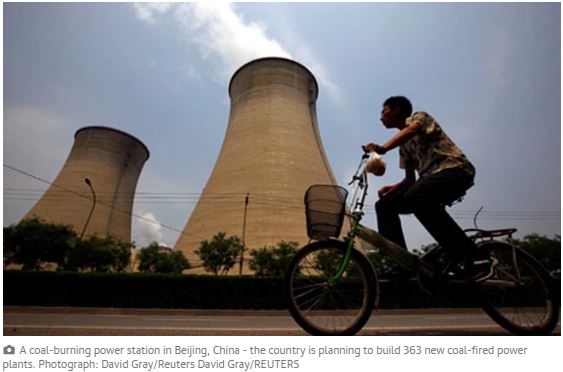World Resources Institute identifies 1,200 coal plants in planning across 59 countries, with about three-quarters in China and India

More than 1,000 coal-fired power plants are being planned worldwide, new research has revealed.
The huge planned expansion comes despite warnings from politicians, scientists and campaigners that the planet’s fast-rising carbon emissions must peak within a few years if runaway climate change is to be avoided and that fossil fuel assets risk becoming worthless if international action on global warming moves forward.
Coal plants are the most polluting of all power stations and the World Resources Institute (WRI) identified 1,200 coal plants in planning across 59 countries, with about three-quarters in China and India. The capacity of the new plants add up to 1,400GW to global greenhouse gas emissions, the equivalent of adding another China – the world’s biggest emitter. India is planning 455 new plants compared to 363 in China, which is seeing a slowdown in its coal investments after a vast building programme in the past decade.
“This is definitely not in line with a safe climate scenario – it would put us on a really dangerous trajectory,” said the WRI’s Ailun Yang, who compiled the report, considered to be the most comprehensive in the public domain. But she said new emissions limits proposed in the US and a voluntary cap on coal use in China could begin to turn the tide. “These policies would give really strong signals about the risks to the future financial performance of coal of climate policies.”
Nick Robins, head of the Climate Change Centre at HSBC, said: “If you think about low-carbon energy only in terms of carbon, then things look tough [in terms of not using coal]. But if you take into account all factors, then dealing with coal [ie not using it] looks a little less difficult.”
He cited the increasing replacement of coal with shale gas and renewable energy, tightening air pollution regulations, the gradual cleaning of economies like China’s and the increasing scarcity of water, which is needed in large quantities by coal-fired power stations.
“We expect financiers and investors increasingly to include these factors into investment decisions for coal to avoid the threat of stranded assets,” Robins said.
The WRI report also found that, after a slight dip during the economic troubles of 2008, the global coal trade has rebounded and rose by 13% in 2010. A structural shift has moved the bulk of the international coal trade from the Atlantic, serving Europe and the US, to the Pacific. China became a net importer of coal in 2009 but the biggest changes are fast-rising imports by Japan, South Korea and Taiwan, which all have large numbers of coal-fired plants but produce virtually no coal of their own.
However, Germany, the UK and France remain in the top 10 importers, and coal use rose 4% in 2011 in Europe as prices fell and plants due to close under clean air rules use up their allotted running hours. Indonesia and Australia are the largest coal exporters, with the latter planning to triple its mine and port capacity to almost 1bn tonnes a year.
Many developing countries, such as Guatemala, Cambodia, Morocco, Namibia, Senegal and Sri Lanka, and Uzbekistan, are planning new coal-fired plants even when they produce almost no coal at all. “There is a long way to go to raise awareness that you can meet energy needs from sources other than coal,” said Yang.
Most new coal-fired plants will be built by Chinese or Indian companies. But new plants have largely been financed by both commercial banks and development banks. JP Morgan Chase has provided more than $16.5bn (£10.3bn) for new coal plants over the past six years, followed by Citi ($13.8bn). Barclays ($11.5bn) comes in as the fifth biggest coal backer and the Royal Bank of Scotland ($10.9bn) as the seventh. The Japan Bank for International Co-operation was the biggest development bank ($8.1bn), with the World Bank ($5.3bn) second.
Guy Shrubsole, at Friends of the Earth, said of the WRI report: “This is a scary number of coal-fired plants being planned. It is clear that the vested interests of coal companies are driving this forward and that they will have to be reined in by governments.”
In January, the Bank of England was warned that fossil fuel sub-prime assets posed a systemic risk to economic stability, because only 20% of the reserves of the top 100 coal and top 100 oil and gas companies could be burned while keeping the global temperature rise under the internationally agreed limit of 2C.

